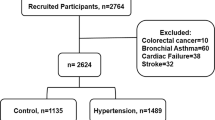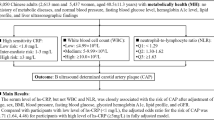Abstract
Inflammation contributes to the development of hypertension. Whether C-reactive protein (CRP) has a causal role in hypertension remains unknown. We studied the relationship between circulating CRP levels and hypertension. The role of single-nucleotide polymorphisms (SNPs) in the CRP gene as determinants of its plasma levels and the propensity to develop hypertension was investigated. Plasma CRP and genotypes of nine SNPs were determined in 1925 unrelated subjects from the Hong Kong Cardiovascular Risk Factor Prevalence Study-2 (CRISPS-2) in 2000–2004. Among 1378 subjects normotensive in CRISPS-2, 1115 subjects had been followed up in CRISPS-3 after a median interval of 5.3 years, 236 of whom had developed hypertension. Plasma CRP was independently associated with the development of hypertension in CRISPS-3 (odds ratio per quartile=1.26, P=0.010). Six SNPs were associated with plasma CRP (all P<0.001). However, none of the SNPs was significantly associated with blood pressure, prevalent or incident hypertension, or change in blood pressure. In conclusion, plasma CRP predicts the development of hypertension. Genetic variants in the CRP gene are significantly associated with plasma CRP but not with hypertension. The future risk of hypertension is therefore more related to plasma CRP than SNPs in the CRP gene in this population.
This is a preview of subscription content, access via your institution
Access options
Subscribe to this journal
Receive 12 digital issues and online access to articles
$119.00 per year
only $9.92 per issue
Buy this article
- Purchase on Springer Link
- Instant access to full article PDF
Prices may be subject to local taxes which are calculated during checkout

Similar content being viewed by others
Accession codes
References
Ridker PM, Hennekens CH, Buring JE, Rifai N . C-reactive protein and other markers of inflammation in the prediction of cardiovascular disease in women. N Engl J Med 2000; 342: 836–843.
Ridker PM, Rifai N, Rose L, Buring JE, Cook NR . Comparison of C-reactive protein and low-density lipoprotein cholesterol levels in the prediction of first cardiovascular events. N Engl J Med 2002; 347: 1557–1565.
Ridker PM, Buring JE, Cook NR, Rifai N . C-reactive protein, the metabolic syndrome, and risk of incident cardiovascular events: an 8-year follow-up of 14 719 initially healthy American women. Circulation 2003; 107: 391–397.
Bautista LE, López-Jaramillo P, Vera LM, Casas JP, Otero AP, Guaracao AI . Is C-reactive protein an independent risk factor for essential hypertension? J Hypertens 2001; 19: 857–861.
Sesso HD, Buring JE, Rifai N, Blake GJ, Gaziano JM, Ridker PM . C-reactive protein and the risk of developing hypertension. JAMA 2003; 290: 2945–2951.
Dauphinot V, Roche F, Kossovsky MP, Schott AM, Pichot V, Gaspoz JM et al. C-reactive protein implications in new-onset hypertension in a healthy population initially aged 65 years: the Proof study. J Hypertens 2009; 27: 736–743.
Davey Smith G, Lawlor DA, Harbord R, Timpson N, Rumley A, Lowe GD et al. Association of C-reactive protein with blood pressure and hypertension: life course confounding and mendelian randomization tests of causality. Arterioscler Thromb Vasc Biol 2005; 25: 1051–1056.
Lakoski SG, Herrington DM, Siscovick DM, Hulley SB . C-reactive protein concentration and incident hypertension in young adults: the CARDIA study. Arch Intern Med 2006; 166: 345–349.
Carlson CS, Aldred SF, Lee PK, Tracy RP, Schwartz SM, Rieder M et al. Polymorphisms within the C-reactive protein (CRP) promoter region are associated with plasma CRP levels. Am J Hum Genet 2005; 77: 64–77.
Kathiresan S, Larson MG, Vasan RS, Guo CY, Gona P, Keaney Jr JF et al. Contribution of clinical correlates and 13 C-reactive protein gene polymorphisms to interindividual variability in serum C-reactive protein level. Circulation 2006; 113: 1415–1423.
Lange LA, Carlson CS, Hindorff LA, Lange EM, Walston J, Durda JP et al. Association of polymorphisms in the CRP gene with circulating C-reactive protein levels and cardiovascular events. JAMA 2006; 296: 2703–2711.
Wang Q, Hunt SC, Xu Q, Chen YE, Province MA, Eckfeldt JH et al. Association study of CRP gene polymorphisms with serum CRP level and cardiovascular risk in the NHLBI Family Heart Study. Am J Physiol Heart Circ Physiol 2006; 291: H2752–H2757.
Lee CC, You NC, Song Y, Hsu YH, Manson J, Nathan L et al. Relation of genetic variation in the gene coding for C-reactive protein with its plasma protein concentrations: findings from the Women's Health Initiative Observational cohort. Clin Chem 2009; 55: 351–360.
Kelley-Hedgepeth A, Lloyd-Jones DM, Colvin A, Matthews KA, Johnston J, Sowers MR et al. Ethnic differences in C-reactive protein concentrations. Clin Chem 2008; 54: 1027–1037.
Cheung BM, Thomas GN . The metabolic syndrome and vascular disease in Asia. Cardiovasc Hematol Disord Drug Targets 2007; 7: 79–85.
Dwivedi G, Beevers DG . Hypertension in ethnic groups: epidemiological and clinical perspectives. Expert Rev Cardiovasc Ther 2009; 7: 955–963.
Cheung BM, Wat NM, Man YB, Tam S, Thomas GN, Leung GM et al. Development of diabetes in Chinese with the metabolic syndrome: a 6-year prospective study. Diabetes Care 2007; 30: 1430–1436.
Cheung BM, Wat NM, Man YB, Tam S, Cheng CH, Leung GM et al. Relationship between the metabolic syndrome and the development of hypertension in the Hong Kong Cardiovascular Risk Factor Prevalence Study-2 (CRISPS2). Am J Hypertens 2008; 21: 17–22.
Cheung BM, Wat NM, Tso AW, Tam S, Thomas GN, Leung GM et al. Raised blood pressure and dysglycemia in Hong Kong Chinese. Diabetes Care 2008; 31: 1889–1891.
Xu A, Tso AW, Cheung BM, Wang Y, Wat NM, Fong CH et al. Circulating adipocyte-fatty acid binding protein levels predict the development of the metabolic syndrome: a 5-year prospective study. Circulation 2007; 115: 1537–1543.
Lui MM, Lam JC, Mak HK, Xu A, Ooi C, Lam DC et al. C-reactive protein is associated with obstructive sleep apnea independent of visceral obesity. Chest 2009; 135: 950–956.
International HapMap Consortium. A haplotype map of the human genome. Nature 2005; 437: 1299–1320.
Nyholt DR . A simple correction for multiple testing for single-nucleotide polymorphisms in linkage disequilibrium with each other. Am J Hum Genet 2004; 74: 765–769.
Barrett JC, Fry B, Maller J, Daly MJ . Haploview: analysis and visualization of LD and haplotype maps. Bioinformatics 2005; 21: 263–265.
Purcell S, Neale B, Todd-Brown K, Thomas L, Ferreira MA, Bender D et al. PLINK: a tool set for whole-genome association and population-based linkage analyses. Am J Hum Genet 2007; 81: 559–575.
Cui JS, Hopper JL, Harrap SB . Antihypertensive treatments obscure familial contributions to blood pressure variation. Hypertension 2003; 41: 207–210.
Ridker PM, Danielson E, Fonseca FA, Genest J, Gotto Jr AM, Kastelein JJ et al. Rosuvastatin to prevent vascular events in men and women with elevated C-reactive protein. N Engl J Med 2008; 359: 2195–2207.
Ridker PM, Danielson E, Fonseca FA, Genest J, Gotto Jr AM, Kastelein JJ et al. Reduction in C-reactive protein and LDL cholesterol and cardiovascular event rates after initiation of rosuvastatin: a prospective study of the JUPITER trial. Lancet 2009; 373: 1175–1182.
Hak AE, Stehouwer CD, Bots ML, Polderman KH, Schalkwijk CG, Westendorp IC et al. Associations of C-reactive protein with measures of obesity, insulin resistance, and subclinical atherosclerosis in healthy, middle-aged women. Arterioscler Thromb Vasc Biol 1999; 19: 1986–1991.
Davey Smith G, Ebrahim S . ‘Mendelian randomization’: can genetic epidemiology contribute to understanding environmental determinants of disease? Int J Epidemiol 2003; 32: 1–22.
Lawlor DA, Harbord RM, Timpson NJ, Lowe GD, Rumley A, Gaunt TR et al. The association of C-reactive protein and CRP genotype with coronary heart disease: findings from five studies with 4610 cases amongst 18 637 participants. PLoS One 2008; 3: e3011.
Schumacher W, Cockcroft J, Timpson NJ, McEniery CM, Gallacher J, Rumley A et al. Association between C-reactive protein genotype, circulating levels, and aortic pulse wave velocity. Hypertension 2009; 53: 150–157.
Komurcu-Bayrak E, Erginel-Unaltuna N, Onat A, Ozsait B, Eklund C, Hurme M et al. Association of C-reactive protein (CRP) gene allelic variants with serum CRP levels and hypertension in Turkish adults. Atherosclerosis 2009; 206: 474–479.
Brunner EJ, Kivimäki M, Witte DR, Lawlor DA, Davey Smith G, Cooper JA et al. Inflammation, insulin resistance, and diabetes—Mendelian randomization using CRP haplotypes points upstream. PLoS Med 2008; 5: e155.
Timpson NJ, Lawlor DA, Harbord RM, Gaunt TR, Day IN, Palmer LJ et al. C-reactive protein and its role in metabolic syndrome: mendelian randomisation study. Lancet 2005; 366: 1954–1959.
Kivimäki M, Lawlor DA, Smith GD, Kumari M, Donald A, Britton A et al. Does high C-reactive protein concentration increase atherosclerosis? The Whitehall II Study. PLoS One 2008; 3: e3013.
Kivimäki M, Lawlor DA, Eklund C, Smith GD, Hurme M, Lehtimäki T et al. Mendelian randomization suggests no causal association between C-reactive protein and carotid intima-media thickness in the young Finns study. Arterioscler Thromb Vasc Biol 2007; 27: 978–979.
Danesh J, Wheeler JG, Hirschfield GM, Eda S, Eiriksdottir G, Rumley A et al. C-reactive protein and other circulating markers of inflammation in the prediction of coronary heart disease. N Engl J Med 2004; 350: 1387–1397.
Folsom AR, Chambless LE, Ballantyne CM, Coresh J, Heiss G, Wu KK et al. An assessment of incremental coronary risk prediction using C-reactive protein and other novel risk markers: the atherosclerosis risk in communities study. Arch Intern Med 2006; 166: 1368–1373.
Cheung BM . The cardiovascular continuum in Asia—a new paradigm for the metabolic syndrome. J Cardiovasc Pharmacol 2005; 46: 125–129.
Purcell S, Cherny SS, Sham PC . Genetic power calculator: design of linkage and association genetic mapping studies of complex traits. Bioinformatics 2003; 19: 149–150.
Acknowledgements
Analysis using the Sequenom genotyping system was performed with the help of Miss Phoebe Ng of the Genome Research Centre, University of Hong Kong. This study was supported by Hong Kong Research Grants Council grants (HKU7229/01M and HKU7626/07M) and the Sun Chieh Yeh Heart Foundation.
Author information
Authors and Affiliations
Consortia
Corresponding authors
Ethics declarations
Competing interests
The authors declare no conflict of interest.
Additional information
Supplementary Information accompanies the paper on the Journal of Human Hypertension website
Supplementary information
Rights and permissions
About this article
Cite this article
Cheung, B., Ong, K., Tso, A. et al. C-reactive protein as a predictor of hypertension in the Hong Kong Cardiovascular Risk Factor Prevalence Study (CRISPS) cohort. J Hum Hypertens 26, 108–116 (2012). https://doi.org/10.1038/jhh.2010.125
Received:
Revised:
Accepted:
Published:
Issue Date:
DOI: https://doi.org/10.1038/jhh.2010.125
Keywords
This article is cited by
-
The effect of nonrestorative sleep on incident hypertension 1–2 years later among middle-aged Hispanics/Latinos
BMC Public Health (2023)
-
Very low-calorie ketogenic diet (VLCKD): an antihypertensive nutritional approach
Journal of Translational Medicine (2023)
-
Reduced masticatory performance and not using dentures are associated with hypertension in older adults with tooth loss: the Shimane CoHRE study
Hypertension Research (2022)
-
Association of hypertension with infection and inflammation in a setting of disadvantage in rural India
Journal of Human Hypertension (2022)
-
The relationship between Plasma Markers and Essential Hypertension in Middle-aged and Elderly Chinese Population: A Community Based Cross-sectional Study
Scientific Reports (2019)



